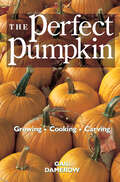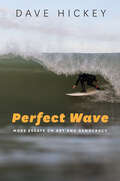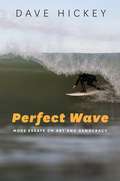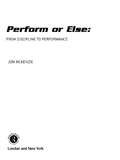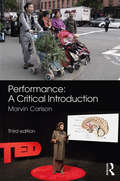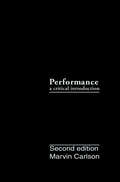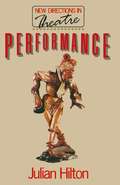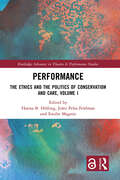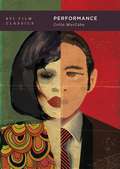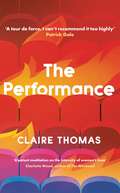- Table View
- List View
Perfect Party Games (The\perfect Ser.)
by Stephen CurtisPerfect Party Games is essential reading for anyone who has a party to plan. Whether you need some ideas to keep everyone entertained at a family get-together or you're organising a big do for your child's whole primary school class, you're bound to find inspiration in this collection of over 200 fun-filled games. With easy-to-follow instructions for everything from 'Alphabet tales' to 'Yes or no', and an indispensable guessing games section offering film, book and TV programme titles, Perfect Party Games will help provide hours of fun for everyone. The Perfect series is a range of practical guides that give clear and straightforward advice on everything from getting your first job to choosing your baby's name. Written by experienced authors offering tried-and-tested tips, each book contains all you need to get it right first time.
The Perfect Pumpkin: Growing/Cooking/Carving
by Gail DamerowThe big orange pumpkin is no longer just for Halloween! Gail Damerow shows you how to cultivate more than 95 varieties of pumpkin, and provides recipes for pumpkin pies, muffins, and even pumpkin beer. You&’ll also learn how to use pumpkins in a variety of craft projects, from carving unique jack-o&’-lanterns to creating pumpkin-scented creams and soaps. With tips on growing giant pumpkins, preserving your harvest through the winter, and much more, The Perfect Pumpkin will delight pumpkin lovers of all sensibilities.
Perfect Wave: More Essays on Art and Democracy
by Dave HickeyWhen Dave Hickey was twelve, he rode the surfer’s dream: the perfect wave. And, like so many things in life we long for, it didn’t quite turn out----he shot the pier and dashed himself against the rocks of Sunset Cliffs in Ocean Beach, which just about killed him. Fortunately, for Hickey and for us, he survived, and continues to battle, decades into a career as one of America’s foremost critical iconoclasts, a trusted, even cherished no-nonsense voice commenting on the all-too-often nonsensical worlds of art and culture. Perfect Wave brings together essays on a wide range of subjects from throughout Hickey’s career, displaying his usual breadth of interest and powerful insight into what makes art work, or not, and why we care. With Hickey as our guide, we travel to Disneyland and Vegas, London and Venice. We discover the genius of Karen Carpenter and Waylon Jennings, learn why Robert Mitchum matters more than Jimmy Stewart, and see how the stillness of Antonioni speaks to us today. Never slow to judge—or to surprise us in doing so—Hickey powerfully relates his wincing disappointment in the later career of his early hero Susan Sontag, and shows us the appeal to our commonality that we’ve been missing in Norman Rockwell. With each essay, the doing is as important as what’s done; the pleasure of reading Dave Hickey lies nearly as much in spending time in his company as in being surprised to find yourself agreeing with his conclusions. Bookended by previously unpublished personal essays that offer a new glimpse into Hickey’s own life—including the aforementioned slam-bang conclusion to his youthful surfing career—Perfect Wave is not a perfect book. But it’s a damn good one, and a welcome addition to the Hickey canon.
Perfect Wave: More Essays on Art and Democracy
by Dave HickeyWhen Dave Hickey was twelve, he rode the surfer’s dream: the perfect wave. And, like so many things in life we long for, it didn’t quite turn out----he shot the pier and dashed himself against the rocks of Sunset Cliffs in Ocean Beach, which just about killed him. Fortunately, for Hickey and for us, he survived, and continues to battle, decades into a career as one of America’s foremost critical iconoclasts, a trusted, even cherished no-nonsense voice commenting on the all-too-often nonsensical worlds of art and culture. Perfect Wave brings together essays on a wide range of subjects from throughout Hickey’s career, displaying his usual breadth of interest and powerful insight into what makes art work, or not, and why we care. With Hickey as our guide, we travel to Disneyland and Vegas, London and Venice. We discover the genius of Karen Carpenter and Waylon Jennings, learn why Robert Mitchum matters more than Jimmy Stewart, and see how the stillness of Antonioni speaks to us today. Never slow to judge—or to surprise us in doing so—Hickey powerfully relates his wincing disappointment in the later career of his early hero Susan Sontag, and shows us the appeal to our commonality that we’ve been missing in Norman Rockwell. With each essay, the doing is as important as what’s done; the pleasure of reading Dave Hickey lies nearly as much in spending time in his company as in being surprised to find yourself agreeing with his conclusions. Bookended by previously unpublished personal essays that offer a new glimpse into Hickey’s own life—including the aforementioned slam-bang conclusion to his youthful surfing career—Perfect Wave is not a perfect book. But it’s a damn good one, and a welcome addition to the Hickey canon.
Perfect Wave: More Essays on Art and Democracy
by Dave HickeyWhen Dave Hickey was twelve, he rode the surfer’s dream: the perfect wave. And, like so many things in life we long for, it didn’t quite turn out----he shot the pier and dashed himself against the rocks of Sunset Cliffs in Ocean Beach, which just about killed him. Fortunately, for Hickey and for us, he survived, and continues to battle, decades into a career as one of America’s foremost critical iconoclasts, a trusted, even cherished no-nonsense voice commenting on the all-too-often nonsensical worlds of art and culture. Perfect Wave brings together essays on a wide range of subjects from throughout Hickey’s career, displaying his usual breadth of interest and powerful insight into what makes art work, or not, and why we care. With Hickey as our guide, we travel to Disneyland and Vegas, London and Venice. We discover the genius of Karen Carpenter and Waylon Jennings, learn why Robert Mitchum matters more than Jimmy Stewart, and see how the stillness of Antonioni speaks to us today. Never slow to judge—or to surprise us in doing so—Hickey powerfully relates his wincing disappointment in the later career of his early hero Susan Sontag, and shows us the appeal to our commonality that we’ve been missing in Norman Rockwell. With each essay, the doing is as important as what’s done; the pleasure of reading Dave Hickey lies nearly as much in spending time in his company as in being surprised to find yourself agreeing with his conclusions. Bookended by previously unpublished personal essays that offer a new glimpse into Hickey’s own life—including the aforementioned slam-bang conclusion to his youthful surfing career—Perfect Wave is not a perfect book. But it’s a damn good one, and a welcome addition to the Hickey canon.
Perfect Wave: More Essays on Art and Democracy
by Dave HickeyWhen Dave Hickey was twelve, he rode the surfer’s dream: the perfect wave. And, like so many things in life we long for, it didn’t quite turn out----he shot the pier and dashed himself against the rocks of Sunset Cliffs in Ocean Beach, which just about killed him. Fortunately, for Hickey and for us, he survived, and continues to battle, decades into a career as one of America’s foremost critical iconoclasts, a trusted, even cherished no-nonsense voice commenting on the all-too-often nonsensical worlds of art and culture. Perfect Wave brings together essays on a wide range of subjects from throughout Hickey’s career, displaying his usual breadth of interest and powerful insight into what makes art work, or not, and why we care. With Hickey as our guide, we travel to Disneyland and Vegas, London and Venice. We discover the genius of Karen Carpenter and Waylon Jennings, learn why Robert Mitchum matters more than Jimmy Stewart, and see how the stillness of Antonioni speaks to us today. Never slow to judge—or to surprise us in doing so—Hickey powerfully relates his wincing disappointment in the later career of his early hero Susan Sontag, and shows us the appeal to our commonality that we’ve been missing in Norman Rockwell. With each essay, the doing is as important as what’s done; the pleasure of reading Dave Hickey lies nearly as much in spending time in his company as in being surprised to find yourself agreeing with his conclusions. Bookended by previously unpublished personal essays that offer a new glimpse into Hickey’s own life—including the aforementioned slam-bang conclusion to his youthful surfing career—Perfect Wave is not a perfect book. But it’s a damn good one, and a welcome addition to the Hickey canon.
Perfect Wave: More Essays on Art and Democracy
by Dave HickeyWhen Dave Hickey was twelve, he rode the surfer’s dream: the perfect wave. And, like so many things in life we long for, it didn’t quite turn out----he shot the pier and dashed himself against the rocks of Sunset Cliffs in Ocean Beach, which just about killed him. Fortunately, for Hickey and for us, he survived, and continues to battle, decades into a career as one of America’s foremost critical iconoclasts, a trusted, even cherished no-nonsense voice commenting on the all-too-often nonsensical worlds of art and culture. Perfect Wave brings together essays on a wide range of subjects from throughout Hickey’s career, displaying his usual breadth of interest and powerful insight into what makes art work, or not, and why we care. With Hickey as our guide, we travel to Disneyland and Vegas, London and Venice. We discover the genius of Karen Carpenter and Waylon Jennings, learn why Robert Mitchum matters more than Jimmy Stewart, and see how the stillness of Antonioni speaks to us today. Never slow to judge—or to surprise us in doing so—Hickey powerfully relates his wincing disappointment in the later career of his early hero Susan Sontag, and shows us the appeal to our commonality that we’ve been missing in Norman Rockwell. With each essay, the doing is as important as what’s done; the pleasure of reading Dave Hickey lies nearly as much in spending time in his company as in being surprised to find yourself agreeing with his conclusions. Bookended by previously unpublished personal essays that offer a new glimpse into Hickey’s own life—including the aforementioned slam-bang conclusion to his youthful surfing career—Perfect Wave is not a perfect book. But it’s a damn good one, and a welcome addition to the Hickey canon.
Perfect Wave: More Essays on Art and Democracy
by Dave HickeyWhen Dave Hickey was twelve, he rode the surfer’s dream: the perfect wave. And, like so many things in life we long for, it didn’t quite turn out----he shot the pier and dashed himself against the rocks of Sunset Cliffs in Ocean Beach, which just about killed him. Fortunately, for Hickey and for us, he survived, and continues to battle, decades into a career as one of America’s foremost critical iconoclasts, a trusted, even cherished no-nonsense voice commenting on the all-too-often nonsensical worlds of art and culture. Perfect Wave brings together essays on a wide range of subjects from throughout Hickey’s career, displaying his usual breadth of interest and powerful insight into what makes art work, or not, and why we care. With Hickey as our guide, we travel to Disneyland and Vegas, London and Venice. We discover the genius of Karen Carpenter and Waylon Jennings, learn why Robert Mitchum matters more than Jimmy Stewart, and see how the stillness of Antonioni speaks to us today. Never slow to judge—or to surprise us in doing so—Hickey powerfully relates his wincing disappointment in the later career of his early hero Susan Sontag, and shows us the appeal to our commonality that we’ve been missing in Norman Rockwell. With each essay, the doing is as important as what’s done; the pleasure of reading Dave Hickey lies nearly as much in spending time in his company as in being surprised to find yourself agreeing with his conclusions. Bookended by previously unpublished personal essays that offer a new glimpse into Hickey’s own life—including the aforementioned slam-bang conclusion to his youthful surfing career—Perfect Wave is not a perfect book. But it’s a damn good one, and a welcome addition to the Hickey canon.
Perfect Wave: More Essays on Art and Democracy
by Dave HickeyA collection of essays by American art critic Dave Hickey, nicknamed “The Bad Boy of Art Criticism.” When Dave Hickey was twelve, he rode the surfer’s dream: the perfect wave. And, like so many things in life we long for, it didn’t quite turn out—he shot the pier and dashed himself against the rocks of Sunset Cliffs in Ocean Beach, which nearly killed him. Hickey went on to develop a career as one of America’s foremost critical iconoclasts, a trusted no-nonsense voice commenting on the worlds of art and culture. Perfect Wave brings together essays on a wide range of subjects from throughout Hickey’s career, displaying his breadth of interest and powerful insight into what makes art work, or not, and why we care. With Hickey as our guide, we travel to Disneyland and Vegas, London and Venice. We discover the genius of Karen Carpenter and Waylon Jennings, learn why Robert Mitchum matters more than Jimmy Stewart, and see how the stillness of Antonioni speaks to us today. Never slow to judge—or to surprise us in doing so—Hickey relates his wincing disappointment in the later career of his early hero Susan Sontag and shows us the appeal to our commonality that we’ve been missing in Norman Rockwell. Bookended by previously unpublished personal essays that offer a new glimpse into Hickey’s own life—including the aforementioned conclusion to his surfing career—Perfect Wave is a welcome addition to the Hickey canon.
Perfection’s Therapy: An Essay on Albrecht Dürer’s Melencolia I (Zone Bks.)
by Mitchell B. MerbackAlbrecht Dürer’s master engraving, Melencolia I, has stood for centuries as a pictorial summa of knowledge about melancholia and an allegory of the limits of earthbound arts and sciences. Zealously interpreted since the nineteenth century, the work also presides over the origins of modern iconology. Yet more than a century of research has left us with a tangle of mutually contradictory theories.In Perfection’s Therapy, Mitchell Merback discovers in Melencolia’s opacity a fascinating possibility: that Dürer’s masterpiece is not only an arresting diagnosis of melancholic distress, but an innovative instrument for its undoing. Merback deftly analyses the visual and narrative structure of Dürer’s image, revisits its philosophical and medical contexts, and resituates it within the long history of the therapeutic artifact. Placing Dürer’s project in dialogue with that of humanism’s founder, Francesco Petrarch, Merback also unearths the German artist’s ambition to act as a physician of the soul.Celebrated by contemporaries as the “Apelles of our age,” and ever since as Germany’s first Renaissance painter-theorist, the Dürer we encounter here is also the first modern Christian artist, addressing himself to the distress of souls, including his own. Melencolia thus emerges as a key reference point in a project of spiritual-ethical therapy, a work designed to exercise the mind, rebalance the passions, remedy the soul, and help in getting on with the project of perfection.
The Perfectly Timed Death of an Imaginary Friend (Oberon Modern Plays)
by Kieran LynnWinner of the Alpine Fellowship Theatre Prize 2018 Sara: Childhood is like a theme park, but there's no re-entry. Once you're in the car park, you have to stay in the car park. Alex: A car park outside a theme park? What a bleak conception of adulthood. Alex and Sara are worried. Their daughter Lee starts school soon and they think her best friend Ernie is going to be a problem. It isn’t that he is badly behaved or mischievous, the problem with Ernie is that he is imaginary. They hatch a plan to force their daughter to grow up and to get rid of Ernie. But as the plan begins to work they learn a lesson that parents usually have to teach their children – Be careful what you wish for.
Perform or Else: From Discipline to Performance
by Jon McKenzie'Performance' has become one of the key terms for the new century. But what do we mean by 'performance'? In today's world it can refer to experimental art; productivity in the workplace; and the functionality of technological systems. Do these disparate fields bear any relation to each other?In Perform or Else Jon McKenzie asserts that there is a relationship cultural, organisational, and technological performance. In this theoretical tour de force McKenzie demonstrates that all three paradigms operate together to create powerful and contradictory pressures to 'perform...or else'. This is an urgent and important intervention in contemporary critical thinking. It will profoundly shape our understanding of twenty-first century structures of power and knowledge.
Perform or Else: From Discipline to Performance
by Jon McKenzie'Performance' has become one of the key terms for the new century. But what do we mean by 'performance'? In today's world it can refer to experimental art; productivity in the workplace; and the functionality of technological systems. Do these disparate fields bear any relation to each other?In Perform or Else Jon McKenzie asserts that there is a relationship cultural, organisational, and technological performance. In this theoretical tour de force McKenzie demonstrates that all three paradigms operate together to create powerful and contradictory pressures to 'perform...or else'. This is an urgent and important intervention in contemporary critical thinking. It will profoundly shape our understanding of twenty-first century structures of power and knowledge.
Performalism: Form and Performance in Digital Architecture
by Yasha J. Grobman Eran NeumanToday, with the advent of digital media technologies and the ability to conceptualize, express and produce complex forms using digital means, the question of the status of the architectural form is once again under consideration. Indeed, the computer liberated architecture from the tyranny of the right angle and enabled the design and production of non-standard buildings, based on irregular geometry. Yet, the questions concerning the method of form expression in contemporary architecture, and its meaning, remain very much open. Performalism takes up this discussion, defines it and presents changes in form conception in architecture, followed by their repercussions. The book is supported by a wealth of case studies from some of the top firms across the globe and contributed to by some of the top names in this field. With a unique and insightful emphasis on professional practice this is essential reading for all architects, aspiring and practicing.
Performalism: Form and Performance in Digital Architecture
by Yasha J. Grobman Eran NeumanToday, with the advent of digital media technologies and the ability to conceptualize, express and produce complex forms using digital means, the question of the status of the architectural form is once again under consideration. Indeed, the computer liberated architecture from the tyranny of the right angle and enabled the design and production of non-standard buildings, based on irregular geometry. Yet, the questions concerning the method of form expression in contemporary architecture, and its meaning, remain very much open. Performalism takes up this discussion, defines it and presents changes in form conception in architecture, followed by their repercussions. The book is supported by a wealth of case studies from some of the top firms across the globe and contributed to by some of the top names in this field. With a unique and insightful emphasis on professional practice this is essential reading for all architects, aspiring and practicing.
Performance: A Critical Introduction (PDF)
by Marvin CarlsonSince its original publication in 1996, Marvin Carlson's Performance: A Critical Introduction has remained the definitive guide to understanding performance as a theatrical activity. It is an unparalleled exploration of the myriad ways in which performance has been interpreted, its importance to disciplines from anthropology to linguistics, and how it underpins essential concepts of human society. In this comprehensively revised and updated third edition, Carlson tackles the pressing themes and theories of our age, with expanded coverage of : the growth and importance of racial and ethnic performance; the emergence of performance concerned with age and disability; the popularity and significance of participatory and immersive theatre; the crucial relevance of identity politics and cultural performance in the twenty-first century. Also including a fully updated bibliography and glossary, this classic text is an invaluable touchstone for any student of performance studies, theatre history, and the performing and visual arts.
Performance: A Critical Introduction
by Marvin CarlsonSince its original publication in 1996, Marvin Carlson's Performance: A Critical Introduction has remained the definitive guide to understanding performance as a theatrical activity. It is an unparalleled exploration of the myriad ways in which performance has been interpreted, its importance to disciplines from anthropology to linguistics, and how it underpins essential concepts of human society. In this comprehensively revised and updated third edition, Carlson tackles the pressing themes and theories of our age, with expanded coverage of : the growth and importance of racial and ethnic performance; the emergence of performance concerned with age and disability; the popularity and significance of participatory and immersive theatre; the crucial relevance of identity politics and cultural performance in the twenty-first century. Also including a fully updated bibliography and glossary, this classic text is an invaluable touchstone for any student of performance studies, theatre history, and the performing and visual arts.
Performance: A Critical Introduction
by Marvin CarlsonSince its original publication in 1996, Marvin Carlson's Performance: A Critical Introduction has remained the definitive guide to understanding performance as a theatrical activity. It is an unparalleled exploration of the myriad ways in which performance has been interpreted, its importance to disciplines from anthropology to linguistics, and how it underpins essential concepts of human society. In this comprehensively revised and updated third edition, Carlson tackles the pressing themes and theories of our age, with expanded coverage of : the growth and importance of racial and ethnic performance; the emergence of performance concerned with age and disability; the popularity and significance of participatory and immersive theatre; the crucial relevance of identity politics and cultural performance in the twenty-first century. Also including a fully updated bibliography and glossary, this classic text is an invaluable touchstone for any student of performance studies, theatre history, and the performing and visual arts.
Performance: A Critical Introduction (PDF)
by Marvin A. CarlsonThis comprehensively revised, illustrated edition discusses recent performance work and takes into consideration changes that have taken place since the book's original publication in 1996. Marvin Carlson guides the reader through the contested definition of performance as a theatrical activity and the myriad ways in which performance has been interpreted by ethnographers, anthropologists, linguists, and cultural theorists. Topics covered include: *the evolution of performance art since the 1960s *the relationship between performance, postmodernism, the politics of identity, and current cultural studies *the recent theoretical developments in the study of performance in the fields of anthropology, psychoanalysis, linguistics, and technology. With a fully updated bibliography and additional glossary of terms, students of performance studies, visual and performing arts or theatre history will welcome this new version of a classic text.
Performance: A Critical Introduction
by Marvin A. CarlsonThis comprehensively revised, illustrated edition discusses recent performance work and takes into consideration changes that have taken place since the book's original publication in 1996. Marvin Carlson guides the reader through the contested definition of performance as a theatrical activity and the myriad ways in which performance has been interpreted by ethnographers, anthropologists, linguists, and cultural theorists. Topics covered include: *the evolution of performance art since the 1960s *the relationship between performance, postmodernism, the politics of identity, and current cultural studies *the recent theoretical developments in the study of performance in the fields of anthropology, psychoanalysis, linguistics, and technology. With a fully updated bibliography and additional glossary of terms, students of performance studies, visual and performing arts or theatre history will welcome this new version of a classic text.
Performance (New Directions in Theatre)
by Julian Hilton...this superb book should be required reading for every drama and literature student and all trainee actors and directors.' Times Higher Educational Supplement
Performance: The Ethics and the Politics of Conservation and Care, Volume I (Routledge Advances in Theatre & Performance Studies)
by Hanna B. Hölling Jules Pelta Feldman Emilie MagninThis book focuses on performance and performance-based artworks as seenthrough the lens of conservation, which has long been overlooked in the largertheoretical debates about whether and how performance remains. Unraveling the complexities involved in the conservation of performance,Performance: The Ethics and the Politics of Conservation and Care (vol. 1)brings this new understanding to bear in examining performance as an object ofstudy, experience, acquisition, and care. In so doing, it presents both theoreticalframeworks and functional paradigms for thinking about—and enacting—theconservation of performance. Further, while the conservation of performance isundertheorized, performance is nevertheless increasingly entering the artmarket and the museum, meaning that there is an urgent need for discourse onhow to care for these works long-term. In recent years, a few pioneering conservators,curators, and scholars have begun to create frameworks for the longtermcare of performance. This volume presents, explicates, and contextualizestheir work so that a larger discourse can commence. It will thus serve the needsof conservation students and professors, for whom literature on this subject issorely needed. This interdisciplinary book thus implements a novel rethinking of performancethat will challenge and revitalize its conception in many fields, such as art history,theater, performance studies, heritage studies, and anthropology.
Performance (BFI Film Classics)
by Colin MacCabeDirected by Donald Cammell and Nicolas Roeg, and starring James Fox, Mick Jagger and Anita Pallenberg, Performance was filmed in 1968, but not released until 1970. When its studio backers saw the director's cut, they were so shocked by the film's sexual explicitness and formal radicalism that attempts were made to destroy the negative. In his study of the film, Colin MacCabe draws on extensive interviews with surviving participants to present the definitive history of the making of Performance, as well as a new interpretation of its consummate artistry.This edition includes an afterword reflecting on the film 50 years on, and the reasons for its continuing classic status. Performance's extraordinary power, suggests MacCabe, comes partly from its entrancing portrayal of London in the late 1960s, but primarily from its full scale assault on any notion of normality, not simply at the level of content but also of form. The remarkable ending, when the thriller and the psychodrama merge into one, means that there is no comfortable resolution to the film's meanings. Performance is one of those rare narrative film which takes us into the complexity of sound and image without the comforting guarantee of a safe exit.
Performance (BFI Film Classics)
by Colin MacCabeDirected by Donald Cammell and Nicolas Roeg, and starring James Fox, Mick Jagger and Anita Pallenberg, Performance was filmed in 1968, but not released until 1970. When its studio backers saw the director's cut, they were so shocked by the film's sexual explicitness and formal radicalism that attempts were made to destroy the negative. In his study of the film, Colin MacCabe draws on extensive interviews with surviving participants to present the definitive history of the making of Performance, as well as a new interpretation of its consummate artistry.This edition includes an afterword reflecting on the film 50 years on, and the reasons for its continuing classic status. Performance's extraordinary power, suggests MacCabe, comes partly from its entrancing portrayal of London in the late 1960s, but primarily from its full scale assault on any notion of normality, not simply at the level of content but also of form. The remarkable ending, when the thriller and the psychodrama merge into one, means that there is no comfortable resolution to the film's meanings. Performance is one of those rare narrative film which takes us into the complexity of sound and image without the comforting guarantee of a safe exit.
The Performance: A Novel
by Claire Thomas'A potent meditation on the intensity of women's lives'Charlotte Wood, author of The Weekend'Thomas writes these women with such wisdom and compassion, that by the end we are all transformed'Claire Fuller, author of Bitter Orange'An intimate, intensely brooding novel: at once claustrophobic and yet revelatory. Thomas gently questions the certainties of modern life that so many of us take for granted'Guinevere Glasfurd, author of The Year Without Summer 'Read it as soon as you possibly can'Emily Bitto, author of The Strays The false cold of the theatre makes it hard to imagine the heavy wind outside in the real world, the ash air pressing onto the city from the nearby hills where bushfires are taking hold.The house lights lower.The auditorium feels hopeful in the darkness.As bushfires rage outside the city, three women watch a performance of a Beckett play.Margot is a successful professor, preoccupied by her fraught relationship with her ailing husband. Ivy is a philanthropist with a troubled past, distracted by the snoring man beside her. Summer is a young theatre usher, anxious about the safety of her girlfriend in the fire zone.As the performance unfolds, so does each woman's story. By the time the curtain falls, they will all have a new understanding of the world beyond the stage.

